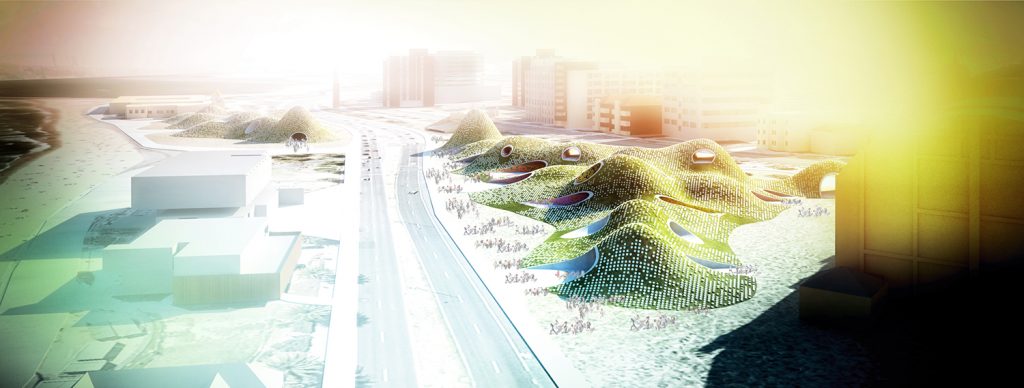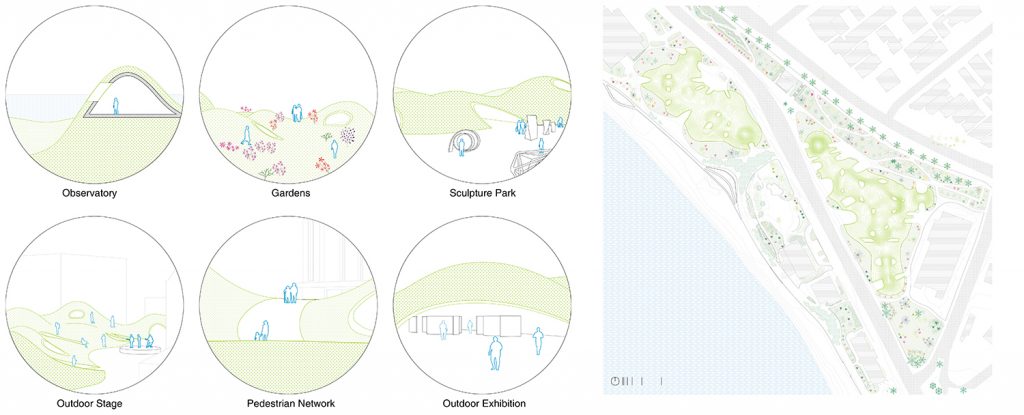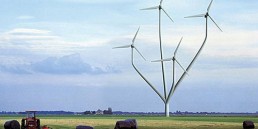
Artist Team: Joo Hyung Oh, Jae Ho Yoon
Energy Technologies: pico wind turbines, energy-generating pavers
Annual Capacity: 960 MWh
A submission to the 2018 Land Art Generator design competition for Melbourne.
When it comes to wind turbines, bigger isn’t always better — at least according to this design team from South Korea.
After conducting a careful study of St Kilda’s wind patterns, Joo Hyung Oh and Jae Ho Yoon determined that it would be more efficient to enlist an army of pico turbines to convert abundant wind resources into electricity for the City of Port Phillip in Australia. Their submission to the 2018 Land Art Generator Initiative competition for Melbourne, called Wind Blossom, incorporates thousands of the tiny turbines, along with Pavegen pavers, to power around 200 Australian homes. And that’s not even the most exciting part of this design proposal.
Oh says he and Yoon decided to create an attractive pathway for visitors moving from the urban side of St Kilda Triangle to the sea side or vice versa. They propose to create a series of undulating landforms carefully designed to not only mitigate disturbance of views, but enhance them. Carved into these green hills are 23 tunnels that capture two major wind currents, including northerly winds along the Esplanade and Jacka Boulevard, and another wind stream rising from St Kilda Beach. Each tunnel was orientated specifically to maximize how much wind energy it could capture.
“My engineering team found that the pin wheel is the most efficient for generating wind energy,” says Oh. “At the same time, the different colors makes for a nice tunnel experience.”

Artist Team: Joo Hyung Oh, Jae Ho Yoon
Energy Technologies: pico wind turbines, energy-generating pavers
Annual Capacity: 960 MWh
A submission to the 2018 Land Art Generator design competition for Melbourne.
The PicoTurbine products they propose to incorporate come from an organization that is far from being a serious energy provider. Nonetheless, the company’s goals are deeply in sync with that of the Land Art Generator Initiative. PicoTurbine International developed as a seed between 1998 and 2007 when Stephen Pendergrast designed a vertical wind turbine for hobbyists. In 2008, Michael Burghoffer bought the brand and expanded it to include both wind and solar kits designed with a view towards education. The company’s vision, according to their website?
Empowering students of all ages by providing them real world STEM skills utilizing student driven problem based learning!
Turns out, their mini turbines are useful for adults too. As pedestrians walk through the tunnels linking different parts of the site along Port Phillip Bay, they have the opportunity to experience wind energy harvesting up-close. And then, further enhancing the experience, the team aims to enlist these visitors in the power production process with Pavegen energy-generating tiles on the surface of the land forms. When walked upon, the tiles activate a slant spring which rotates a generator to produce additional energy for the site.

Artist Team: Joo Hyung Oh, Jae Ho Yoon
Energy Technologies: pico wind turbines, energy-generating pavers
Annual Capacity: 960 MWh
A submission to the 2018 Land Art Generator design competition for Melbourne.
“We want to encourage human activity on our site… [and] create a connection between the urban side and the sea side instead of dividing the two with some kind of humongous energy generator,” says Oh. “We chose to integrate energy from nature and energy from the people,” adds the team’s engineer, Jae Ho Yoon.
These days public art is not just a communicator of the artist,” says Yoon. “Public art is a kind of communication channel of diverse people…the participation of the people is also part of the arts.
LAGI’s co-founders Elizabeth Monoian and Robert Ferry say that Wind Blossom underscores the potential of Land Art Generator artworks to add experiential value to any given site or city while opening visitors’ eyes to the infinite design opportunities for urban energy generation. They add:
We love the indecipherable merging of land, energy, people, and art that results from the Wind Blossom design.

Artist Team: Joo Hyung Oh, Jae Ho Yoon
Energy Technologies: pico wind turbines, energy-generating pavers
Annual Capacity: 960 MWh
A submission to the 2018 Land Art Generator design competition for Melbourne.
Rising to the challenge of what Yoon calls the vertex of infrastructure and the arts has been on Oh’s radar since the 2016 Land Art Generator Competition for Santa Monica. With that site so close to his home in California, he became intrigued by the design possibilities—but learned about it too late to enter. Although removed from the site in Australia, he and Yoon were ready to throw their hat in the ring.
“This competition really aligns with our research,” he says of his company Pentatonic, “and motivated us to elevate our design vision.”
Tafline Laylin is a freelance communicator and journalist who strives for global environmental and social justice. Her work has appeared in The Guardian, The Atlantic, OZY.com, and a variety of other international publications.

